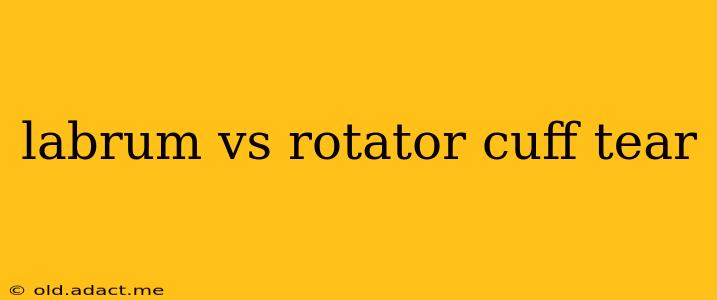Shoulder pain is a common ailment, often stemming from injuries to the labrum or rotator cuff. While both structures are crucial for shoulder stability and function, they are distinct, and their injuries present with different characteristics. This article clarifies the differences between a labral tear and a rotator cuff tear, helping you understand the nuances of these conditions.
What is a Labrum Tear?
The labrum is a ring of cartilage that surrounds the glenoid, the socket of your shoulder joint. It deepens the socket, providing stability and aiding in smooth joint movement. A labral tear is a damage to this cartilage, often caused by a sudden impact, repetitive overhead motions, or simply from the wear and tear of aging.
Types of Labral Tears:
Labral tears can be classified in several ways, including:
- SLAP (Superior Labrum Anterior to Posterior) lesions: These tears affect the upper part of the labrum, often involving the biceps tendon attachment.
- Bankart lesions: These tears occur in the anterior (front) portion of the labrum and are commonly associated with shoulder dislocations.
Symptoms of a Labrum Tear:
Symptoms can vary widely depending on the severity and location of the tear. Some individuals may experience:
- Clicking or popping in the shoulder
- Shoulder pain, particularly during overhead activities or reaching
- A feeling of instability or giving way in the shoulder
- Limited range of motion
What is a Rotator Cuff Tear?
The rotator cuff is a group of four muscles and their tendons that surround the shoulder joint. These muscles are responsible for rotating the arm, lifting the arm overhead, and stabilizing the shoulder. A rotator cuff tear involves damage to one or more of these tendons, often due to overuse, injury, or age-related degeneration.
Types of Rotator Cuff Tears:
Rotator cuff tears are categorized by their size and location:
- Partial-thickness tears: Only a portion of the tendon is torn.
- Full-thickness tears: The tendon is completely torn.
- Small, medium, or large tears: Describes the size of the tear.
Symptoms of a Rotator Cuff Tear:
Symptoms of a rotator cuff tear often include:
- Shoulder pain, particularly at night or with specific movements
- Weakness in the shoulder
- Limited range of motion
- Difficulty sleeping on the affected side
- Atrophy (muscle wasting) in the shoulder area
Labrum Tear vs. Rotator Cuff Tear: Key Differences
While both conditions cause shoulder pain and affect movement, there are key distinctions:
| Feature | Labrum Tear | Rotator Cuff Tear |
|---|---|---|
| Affected Area | Cartilage ring surrounding the shoulder joint | Tendons of the rotator cuff muscles |
| Common Cause | Sudden impact, repetitive movements, aging | Overuse, injury, aging |
| Primary Symptom | Clicking, popping, instability, pain | Pain, weakness, limited range of motion |
| Treatment | Physical therapy, surgery (in severe cases) | Physical therapy, surgery (in severe cases) |
How are Labrum and Rotator Cuff Tears Diagnosed?
Diagnosis typically involves a physical examination, patient history, and imaging studies such as:
- X-rays: Rule out fractures or other bone problems.
- MRI: Provides detailed images of the soft tissues, including the labrum and rotator cuff.
- Ultrasound: Another imaging technique to visualize the soft tissues.
Can you have both a labrum and rotator cuff tear?
Yes, it's possible to have both a labrum tear and a rotator cuff tear simultaneously. Often, the injuries are related, with one injury potentially causing or exacerbating the other. A comprehensive evaluation by a medical professional is crucial for accurate diagnosis and treatment planning.
What is the treatment for a labrum or rotator cuff tear?
Treatment options depend on the severity of the tear and the individual's symptoms and activity level. Common treatments include:
- Physical therapy: To strengthen the surrounding muscles and improve shoulder stability and function.
- Medication: To reduce pain and inflammation.
- Surgery: May be necessary for severe tears that don't respond to conservative treatment. Arthroscopic surgery is often used for minimally invasive repair.
This information is for educational purposes only and does not constitute medical advice. Always consult with a healthcare professional for diagnosis and treatment of any medical condition.
